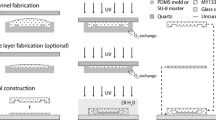Abstract
In this paper, we present object manipulation methodologies in microfluidic devices based on object-photon interactions. Devices were fabricated by polydimethylsiloxane (PDMS) elastomer molding of channel structures over photolithographically defined patterns using a thick negative photoresist. Inorganic objects including polystyrene spheres and organic objects including live cells were transferred into fluidic channels using a syringe pump. The objects were trapped and manipulated within the fluidic channels using optical tweezers formed by VCSEL arrays, with only a few mW of optical power. We have also shown that it is possible to manipulate multiple objects as a whole assemble by using an optically-trapped particle as a handle, or an “optical handle”. Optical manipulation will have applications in biomedical devices for drug discovery, cytometry and cell biology research.
Similar content being viewed by others
References
Paulus, A., “Planar glass and plastic micromachined devices for drug development in the post-genomic era”, Proceedings of International Conference on Microtechnologies: MICRO.tec 2000, Vol.2, pp. 499–504 (2000).
Roberts, K.; Williamson, F., Cibuzar, G. and Thomas, L., “The fabrication of an array of microcavities utilizing SU-8 photoresist as an alternative ‘LIGA’ technology”, Proceedings of the Thirteenth Biennial University/Government/Industry Microelectronics Symposium, pp. 139–41 (1999).
Richardson, J., Hawkins, P. and Luxton, R., “The use of coated paramagnetic particles as a physical label in a magneto-immunoassay”, Biosensors & Bioelectronics, vol. 16, (no. 9-12), Elsevier (2001).
Khandurina, J., “Integrated system for rapid PCR-based DNA analysis in microfluidic devices”, Analytical Chemistry, 72, pp. 2995–3000 (2000).
Buccholz, B.A., “Microchannel DNA sequencing matrices with a thermally controlled viscosity switch”, Analytical Chemistry, 73, pp. 157–164 (2001).
Xia, Y. and Whitesides, G. M., Angew., “Soft Lithography”, Chem. Int. Ed. Engl. 1998, 37, 550–575.
Chu, D.T., Jeon, N.L., Huang, S., Kane, R., Wargo, C., Choi, I.S., Ingber, D., Whitesides, G., “Patterned deposition of cells and proteins onto surfaces by using three-dimensional systems”, PNAS, 97, 6, pp. 2408–2413 (2000).
K. Sasaki, M. Koshioka, H. Misawa, N. Kitamura, and H. Masuhara, “Pattern formation and flow control of fine particles by laser-scanning micromanipulation,” Opt. Lett. 16, 1463–1465 (1991).
E. R. Dufresne and D. G. Grier, “Optical tweezer arrays and optical substrates created with diffractive optics,” Rev. Sci. Instrum. 69, 1974–1977 (1998).
M. Reicherter, T. Haist, E. U. Wagemann, and H. J. Tiziani, “Optical particle trapping with computer-generated holograms written on a liquid-crystal display,” Opt. Lett. 24, 608–610 (1999)
O. Kibar, R. A. Flynn, and S. C. Esener, OSA Topical Meeting on Spatial Light Modulators Technical Digest (Optical Society of America, Washington DC), 49–51 (1999).
Author information
Authors and Affiliations
Rights and permissions
About this article
Cite this article
Ata, E., Birkbeck, A.L., Ozkan, M. et al. Optical Manipulation of Objects in Microfluidic Devices. MRS Online Proceedings Library 729, 16 (2002). https://doi.org/10.1557/PROC-729-U1.6
Published:
DOI: https://doi.org/10.1557/PROC-729-U1.6




